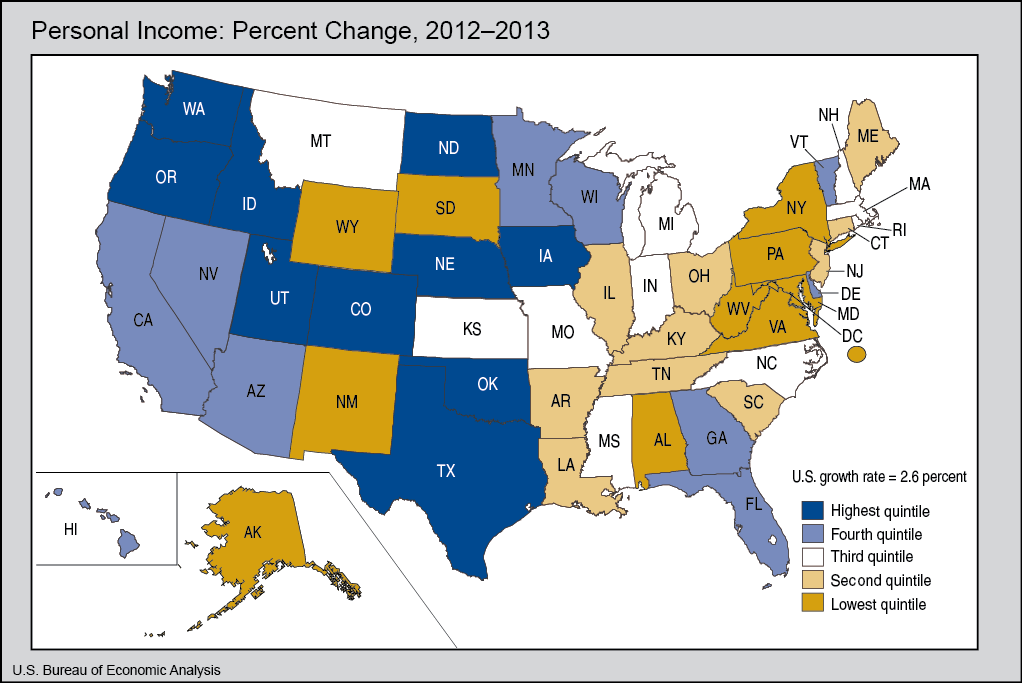Accounting
Which States Have the Highest Personal Income Growth?
Average personal income in the United States grew by 2.6 percent in 2013, which is mixed news since that reflects a slowing of income growth from 4.2 percent in 2012. All 50 states and the District of Columbia realized gains in average personal income during the year, according to data from the Bureau of Economic Analysis.
Mar. 27, 2014

Average personal income in the United States grew by 2.6 percent in 2013, which is mixed news since that reflects a slowing of income growth from 4.2 percent in 2012. All 50 states and the District of Columbia realized gains in average personal income during the year, according to data from the Bureau of Economic Analysis.
Which states topped the list? North Dakota, with a growth of 7.6 percent took the top spot, led largely by its booming oil and gas economy.
- North Dakota – 7.6%
- Utah – 4.0
- Idaho – 3.75
- Texas – 3.7
- Oregon – 3.5
The worst performing states in terms of personal income growth were West Virginia (1.5 percent), Maryland (1.6), New Mexico (1.7), Alaska (1.7) and Virginia (1.7).
BEA's report suggested the slower personal income growth reflected the effects of several factors including the expiration of the “payroll tax holiday” at the beginning of 2013. That was a temporary two-percentage point reduction in the personal contribution rate for social security. Other factors may have included the acceleration of the receipt of income, especially personal dividends and salary bonuses, into 2012 in anticipation of changes in individual income tax rates for 2013. The expiration of the payroll tax holiday increased contributions for government social insurance, a subtraction in the calculation of personal income.
Earnings by industry. Nationwide, earnings grew in 2013 in every industry except civilian federal government, which fell $6.7 billion. Earnings growth slowed, however, in most private-sector industries in 2013. Among the few exceptions with accelerating growth, construction and farming were notable.
Earnings growth was greatest in professional services (up $44.6 billion), construction (up $44.3 billion), and health care (up $42.5 billion). These 3 industries contributed the most to earnings growth in 2012 as well.
Earnings by state and industry. Earnings grew 1.2 percent in 2013 in West Virginia, the net effect of declines in ten industries, including mining, durable goods manufacturing, and construction, and gains in 14 industries, including health care and professional services.
The relatively slow earnings growth in 2013 in the District of Columbia (1.6 percent), Maryland (2.0 percent), and Virginia (2.1 percent) reflects a $1.1 billion decline in civilian federal government earnings in the region due to furloughs and other measures.
Nevada’s 4.3 percent earnings growth in 2013 exceeded the national average for the first time since the recession ended in 2009. (Before the recession Nevada’s earnings growth typically outpaced the nation). The construction and accommodations industries provided the largest contributions to earnings growth in Nevada in 2013.
Mining (including oil and gas extraction) was one of the major contributors to earnings growth in North Dakota, Oklahoma, and Texas in 2013. Earnings growth rates in these three states have outpaced the national average not only in 2013, but in each of the four years since the recession.
Fourth quarter personal income. State personal income growth slowed to 0.6 percent in the fourth quarter of 2013, from 1.0 percent in the third quarter. Growth ranged from 1.2 percent in Texas to -0.6 percent in Iowa. The fourth-quarter personal income decline in Iowa and six other states reflected lower crop prices which reduced the value of farm output and farm earnings. The inflation rate slowed to 0.3 percent in the fourth quarter from 0.5 percent in the third quarter.
